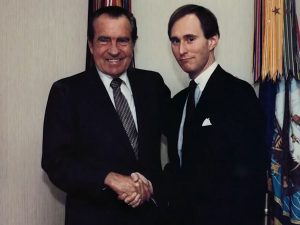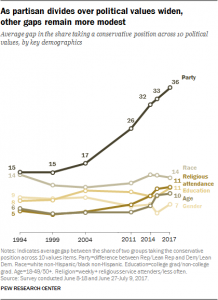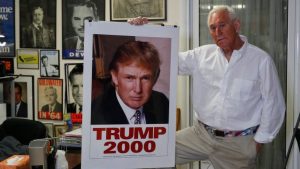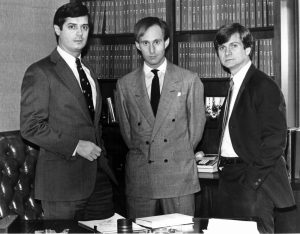How Roger Stone Gave Rise to the Partisan Divide of Today
May 9th, 2022
Tejas Sinha
Dirty Politics: How Roger Stone Gave Rise to the Partisan Divide of Today
I. Introduction: Nixon and the Rise of Roger Stone
As political polarization in the United States has risen over the last few decades, the American people have become more and more divided. While this is a complex problem with multiple factors, much of it can be attributed to the proliferation of corruption, both legal and illegal, beginning in the Nixon era. Corruption, which is defined as “the abuse of entrusted power for private gain,” decreases transparency and weakens our democracy. During an age of massive issues that require international cooperation such as global warming and the threat of nuclear warfare, it is imperative that the US be united and decisive in order to play its part as a global leader. This makes political polarization one of the most pressing issues of our time. To understand the polarization that America experiences today, we must first understand one of the pioneers of corruption and dirty politics in Washington: Roger Stone.
Stone got his ticket into politics through the Nixon administration. His respect for the former president is profound; nothing is more telling than the tattoo on Stone’s back, a portrait of a smiling President Nixon located right below his neck. From Nixon’s infamously corrupt administration, Stone inherited a frightening win-at-all-costs mentality and popularized legal tactics to unjustly influence American politics.

Stone was just a young college student when Bart Porter, the scheduling director of the Committee to Reelect Nixon, brought him in as an assistant. Amidst the greater corruption of the Nixon administration, Stone’s role was small: approach the office of Pete McCloskey, Nixon’s competitor for the Republican nomination at the time, and pretend to be a member of the Young Socialist Alliance. Offer him a jar full of money on behalf of the Alliance and ask for a receipt. Lastly, send the receipt to the newspaper to discredit McCloskey as a communist. Fortunately for McCloskey, the newspaper refused to run the story and nothing came out of the affair.
While Stone’s first dirty trick was small and inconsequential, his actions were brought to light as collateral during the Watergate investigation. When he was called in front of the Watergate Grand Jury, Stone knew he had stumbled upon a golden opportunity to advance his career. It did not matter if he had actually played a big role in Watergate just as long as people thought he had played a big role. Now, politicians would look at Stone as someone who could help them get ahead. This was the beginning of Stone’s reputation as a master of dirty politics.
Over time, Stone would live up to the role ascribed to him through his revolutionary tactics in the campaigning and lobbying sectors. In 1975, Roger co-founded the National Conservative Political Action Committee, known as NCPAC, which in his own words pioneered “negative campaign advertising in massive doses to win elections.” Working from within a political action committee (PAC) rather than a campaign allowed him to bypass newly imposed campaign spending limits meant to restrict the influence of money in elections and combat corruption. While negative campaigning had existed before, it did not dominate campaigns as it does today. To illustrate, from 2008 to 2018, about 70% of ads ran during election years and midterm election years were negative.
Stone then went on to leverage his influence in the campaign space to start a lobbying firm with Charles Black and Paul Manafort, two other consultants who had been working for Reagan. Black Manafort & Stone was one of the first of its kind. As a lobbying firm whose members had helped the current president get elected, the firm was essentially selling access to the Reagan administration. Before Black Manafort & Stone, this practice was viewed as highly unethical. Harry Siegel, editor for the Daily Beast, explains that, “They crossed a line that hadn’t been crossed; Washington’s been worse for it ever since.” Motivated purely by profit, the firm’s clients included dictators such as Ferdinand Marcos of the Philippines, Mobutu Sese Seko of the Democratic Republic of Congo, and the leader of the National Union for the Total Independence of Angola, Jonas Savimbi. By representing these dictators, Black Manafort & Stone gave a voice to human-rights abusers in Washington and paved the way for other lobbyists to do the same.

Stone did not create corruption in Washington, nor is he the sole source of today’s polarization. From the Corrupt Bargain of 1824 to political machines and the spoils system in the Gilded Age, there are many examples of corruption in American politics. What makes Stone different is the brazenness with which he embraced such policies. No longer was corruption something to be hidden behind closed doors; after Stone, it became the norm. In this sense, Stone was an innovator who brought dirty tactics to the forefront of American politics and influenced many along the way. There is a direct connection between the popularization of dirty politics by Stone and the current polarization in both American government and society.
II. Today’s Polarization
There is a plethora of evidence showing how much polarization has increased in the United States. According to a study by the Pew Research Center, an independent nonpartisan think tank, there is now a 36-percentage-point gap between Republicans and Democrats on major political issues. This figure has increased steadily since 1994, when the gap was only 15 percent. Compared to other key demographics such as race, religion, and gender, political party is by far the biggest indicator of disagreement on an issue.
At the same time, while political polarization has increased, public trust in government has fallen to one of its lowest points ever. Currently, only 24 percent of Americans–36 percent of Democrats and 9 percent of Republicans– say they can trust the government. This number has been steadily decreasing from a high of 77 percent in 1965.
To understand the true significance of these metrics, one must look no further than January 6, 2021 when a mob of Trump supporters descended on the Capitol in an attempt to overturn the results of the 2020 election. The lives of our elected officials were in danger as the Capitol police were overwhelmed and the protestors stormed into the Capitol Building. Most alarmingly, these actions seemed to be encouraged by former President Donald Trump at a rally just hours before the insurrection. President Trump would go on to be impeached for his involvement.
In the past, something like this would have been inconceivable to most Americans. But as we see the effects of a decades-long trend of increasing political polarization and lack of trust in the government, these extreme scenarios could become more common. Yet again, Roger Stone and his political strategies can be linked to this unforgettable day in American history.
III. President Trump and Roger Stone
To understand the chaos that transpired at the end of Trump’s term, we must first look back to its beginning. From its conception, the Trump campaign was full of divisive rhetoric. Much of it was targeted towards minorities, playing on the building unrest among his voter base of predominantly white Americans worried about the rapidly changing climate of America. He claimed that he saw “thousands and thousands of people cheering” as the World Trade Centers came down, and called for a “total and complete shutdown of Muslims entering the United States.” He promised to build a wall between the US and Mexico to keep out immigrants he described as “rapists,” “bringing drugs,” and “bringing crime,” before adding that “some, I assume, are good people.” The effect of this type of rhetoric was twofold: by painting these images of minority groups as something to be feared, he capitalized on today’s polarized climate while attracting an incredible amount of media attention. It’s no mistake that such a polarizing campaign produced an administration with such a polarizing end.

Not many foresaw Trump becoming president. But Roger Stone had been pushing him to run as early as 1987. In fact, Stone’s influence can be found all over Trump’s presidential run. Even after Stone was fired from the campaign, his influence was evident in Trump’s negative campaigning strategies, disregard of factual accuracy, and campaign hires. For example, Trump repeatedly accused Bill Clinton of raping women and Hillary Clinton of threatening them–a topic that Stone wroke a book on in 2015. He entertained the baseless claim that Obama was secretly born outside of the country, something that Stone called “brilliant base building.” And when Trump fired campaign manager Corey Lewandowski, he hired Paul Manafot, longtime Roger Stone associate, on Stone’s recommendation. As Jeffery Toobin, writer for the New Yorker says, “There is no doubt that in tone, in affect, in profile, the Trump candidacy was a pure Roger Stone production.”
IV. Stone’s Influence on Politics Today
To analogously understand Stone’s influence on politics today, one can use an economic principle. Gresham’s Law states that bad money drives out the good. The traditional case of Gresham’s law is when bad money is legal tender, meaning the law requires it to be accepted as payment of debt. Since the payee is forced to accept it as payment despite its quality, everyone spends the bad money and saves the good, effectively taking the good money out of the market.
This scenario assumes that both the payer and payee have equal information on the quality of the currency. However, if information is unequal among the payer and payee, the good money will still be driven out by the bad, even if the bad money is not legal tender. If the payee does not know that the money is bad, they will accept it as payment from the payer whether they are required to or not. Again, good money gets pushed out of the market.
After looking at this second scenario, a similar phenomenon can be observed in politics. Think of corrupt politicians as bad money and non-corrupt politicians as good money. The corrupt practices that Stone and others pioneered in the late 20th century are so effective that they have become necessary to keep up with the competition, increasing the circulation of power hungry politicians in the market. Because these corrupt practices are so effective and covert, the general public is not aware of them. Therefore, the public accepts corrupt politicians as their representatives, which only deepens polarization.
For example, take the highly effective mass negative campaigning methods that Stone advanced at Black Manafort & Stone. If one side starts using these tactics, the other side is incentivized to start using them as well in order to keep up with the competition. As the two sides take turns attacking each other, their respective voter base’s view of the other side becomes more and more distorted, and the two sides become more and more polarized. In this way, the use of corrupt practices activates a cycle that only reinforces more corrupt practices to compete, thereby increasing polarization. At the same time, public trust in government decreases, as they are constantly hearing each party denounce government officials of the opposite. Roger Stone is aware of this phenomenon when he once said, “The slash and burn politics of today are what’s required to get noticed.”
This is just one example of how corruption increases polarization. Due to the lack of information available to the public about what happens behind the scenes in Washington, corruption in politics creates a problem of “asymmetric information.” Because the corrupt actor is able to gain an unfair advantage without taking major damage to their reputation, he has a strong incentive to act corruptly. When the corrupt actor is able to get away with this on a regular basis, politicians who choose to abstain from corruption are at a considerable disadvantage. Hence, “Good politicians are driven out from the political market by the bad ones.”
With every new form of corruption that arises in Washington, this reinforcing cycle of corruption gets worse. It is no coincidence that it was during the Nixon administration when trust in government began to decline and has not recovered since that time.. From Nixon to Stone to Trump, we can see how corruption has bred corruption. Unless this cycle is stopped, the January 6th insurrection is only a preview of what is to come.
V. Solutions: How to Clean Up Politics
To reduce polarization and restore trust in government, this cycle of corruption and dirty politics must be stopped. While there has been discussion of stricter laws to prevent corruption, the feasibility of such a solution is questionable given that the body responsible for creating these regulations is full of corruption itself. To truly solve this problem, we must find another way to disincentivize politicians from engaging in corruption.

Going back to case two of Gresham’s Law, the reason that good money is driven out by the bad is due to a lack of information. Consumers, unaware that the bad money has little value, accept it as payment from the seller. However, if there existed a credible source of information available to all buyers and sellers, the bad money would cease to be accepted. By applying this solution to the case of politics, we get the answer to the cycle of corruption: information. If there existed a universal, unbiased source of information on the behaviors of all political candidates in Washington, those that choose to engage in corruption would be voted out.
Obviously, that’s an ideal. It would be impossible to know everything about a candidate’s behavior without severely violating individual liberties. Instead, we can look to education as an answer. The public must be aware of the corruption that goes on in Washington and be able to identify corrupt tactics when they see them. Students must be taught in schools not only about the three branches of government and how they function, but also about the roles of political advisors, lobbyists, and PACs. Students must understand how toxic our current political environment has become, look past today’s divisive political rhetoric, and begin to reduce polarization by holding our politicians accountable.
This approach will be challenging. The information must be unbiased and nonpartisan, and even if it is, there is a large chance that it will face pushback from those in the public already under the influence of today’s polarizing politics. But there is no mistake that the fixing of our democracy must start with the people.
Bibliography
“61% Increase in Volume of Negative Ads.” Wesleyan Media Project. October 30, 2018. https://mediaproject.wesleyan.edu/103018/.
Aqui, Reggie and Eric Shackelford. “Roger Stone’s tattoo of former President Richard Nixon goes viral.” ABC 13 Eyewitness News. January 25, 2019. https://abc13.com/roger-stone-does-have-a-nixon-tattoo-back-of/5107227/.
Albert, Rocío, and Francisco Cabrillo. “Gresham’s Law in Politics: Why Are Politicians Not the Most Remarkable Men for Probity and Punctuality?” European Journal of Law and Economics 21, no. 2 (April 2006): 99–112. https://doi.org/10.1007/s10657-006-6644-3.
Bank, Dylan, Daniel DiMauro, and Morgan Pehme, dirs. Get Me Roger Stone. Netflix. 2017. https://www.netflix.com/title/80114666.
Berger, Sam and Alex Tausanovitch. “Lessons from Watergate: Preparing for Post-Trump Reforms.” Center for American Progress. July 20, 2018. https://www.americanprogress.org/article/lessons-from-watergate/.
Dimock, Michael and Richard Wike. “America is Exceptional in Its Political Divide.” PEW. March 29, 2021. https://www.pewtrusts.org/en/trust/archive/winter-2021/america-is-exceptional-in-its-political-divide.
Doherty, Carroll. “Key takeaways on Americans’ growing partisan divide over political values.” PEW Research Center. October 5, 2017. https://www.pewresearch.org/fact-tank/2017/10/05/takeaways-on-americans-growing-partisan-divide-over-political-values/.
Heilpern, Will. “Trump Campaign: 11 Outrageous Quotes.” CNN, December 31, 2015. https://www.cnn.com/2015/12/31/politics/gallery/donald-trump-campaign-quotes/index.html.
Fandos, Nicholas. “Trump Impeached for Inciting Insurrection.” The New York Times. January 14, 2021. https://www.nytimes.com/2021/01/13/us/politics/trump-impeached.html.
“Frequently Asked Questions.” The American Anti-Corruption Act. Accessed on May 5, 2022. https://anticorruptionact.org/faq/.
“Public Trust in Government: 1958-2021.” PEW Research Center. May 17, 2021. https://www.pewresearch.org/politics/2021/05/17/public-trust-in-government-1958-2021/.
The Editors of Encyclopedia Britannica. “Gresham’s Law.” Britannica. Accessed on May 7. 2022. https://www.britannica.com/topic/Greshams-law.
“What is Corruption?” Transparency International. Accessed on May 5, 2022. https://www.transparency.org/en/what-is-corruption.